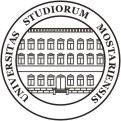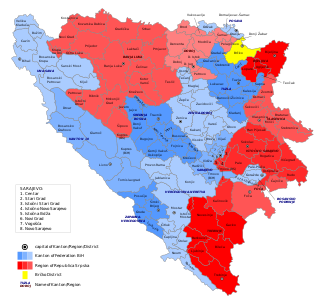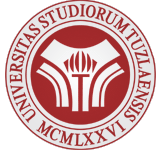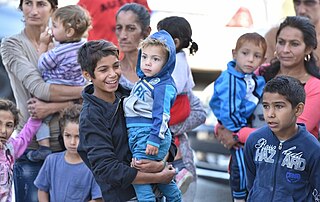
The Herzegovina-Neretva Canton is one of 10 cantons of the Federation of Bosnia and Herzegovina in Bosnia and Herzegovina.

The Football Association of Bosnia and Herzegovina, based in Sarajevo, is the chief officiating body of football in Bosnia and Herzegovina. The Bosnian football association was founded as the Sarajevo football sub-association of Yugoslavia in 1920. In 1992, the association was re-founded as the Football Association of Bosnia and Herzegovina.

The University of Mostar is the largest public university located in Mostar, Bosnia and Herzegovina.

In Bosnia and Herzegovina, the smallest administrative unit is the municipality. Prior to the 1992–95 Bosnian War there were 109 municipalities in what was then Socialist Republic of Bosnia and Herzegovina. Ten of these formed the area of the capital Sarajevo.

Džemal Bijedić was a Bosnian and Yugoslav politician who served as Prime Minister of Yugoslavia from July 1971 until his death in a plane crash in January 1977. He additionally served as Secretary of the Interior from July to December 1971. Bijedić was also President of the People's Assembly of SR Bosnia and Herzegovina from 1967 to 1971.

The University of Banja Luka is the second-oldest university in Bosnia and Herzegovina. A public university, it is the flagship institution of higher education in Republika Srpska, one of two entities of Bosnia and Herzegovina. As of 2018–19 school year, there are 11,186 enrolled students.

University of Tuzla is a public university located in Tuzla, Bosnia and Herzegovina. The university was founded in 1958. It became a proper university in 1976, and today is one of the major institutions of higher learning in Bosnia and Herzegovina.

Mediterranean University is a university located in Podgorica, Montenegro. It was founded on 30 May 2006, is the first private university established in Montenegro and is organized in 6 faculties. The university is member of the Balkan Universities Network.
Association football is the most popular sport in Bosnia and Herzegovina since after gaining independence from Yugoslavia in 1991, in 1995 they played their first international game against Albania, but they made the debut at the 2014 FIFA World Cup in Brazil, their first ever appearance in the tournament.

The most widely professed religion in Bosnia and Herzegovina is Islam and the second biggest religion is Christianity. Nearly all the Muslims of Bosnia are followers of the Sunni denomination of Islam; the majority of Sunnis follow the Hanafi legal school of thought (fiqh) and Maturidi theological school of thought (kalām). Bosniaks are generally associated with Islam, Croats of Bosnia and Herzegovina with the Roman Catholic Church, and Bosnian Serbs with the Serbian Orthodox Church. The State Constitution of Bosnia and Herzegovina (BiH) and the entity Constitutions of the Federation of Bosnia and Herzegovina and the Republika Srpska provide for freedom of religion, and the Government generally respects this right in ethnically integrated areas or in areas where government officials are of the majority religion; the state-level Law on Religious Freedom also provides comprehensive rights to religious communities. However, local authorities sometimes restricted the right to worship of adherents of religious groups in areas where such persons are in the minority.

The Xoraxane in Bosnia and Herzegovina are the largest of the 17 national minorities in the country, although—due to the stigma attached to the label—this is often not reflected in statistics and censuses.

Beer is a popular beverage in Bosnia and Herzegovina.

University Džemal Bijedić of Mostar is a public university located in Mostar, Bosnia and Herzegovina. It was established in 1977 and is named after Mostar-born Bosnian and Yugoslav politician Džemal Bijedić. It consists of eight faculties.

The School of Economics and Business (SEBS) is a business school affiliated with the University of Sarajevo. It is often known by its former name, the Faculty of Economics
Husnija Kamberović is a Bosnian historian and a professor of modern history at the Faculty of Philosophy, University of Sarajevo, in Sarajevo, Bosnia and Herzegovina.















